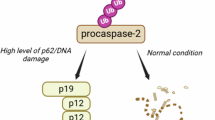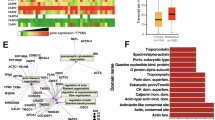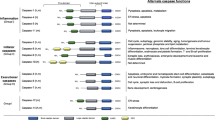Abstract
Caspases are considered to be the key effector proteases of apoptosis. Initiator caspases cleave and activate downstream executioner caspases, which are responsible for the degradation of numerous cellular substrates. We studied the role of caspases in apoptotic cell death of a human melanoma cell line. Surprisingly, the pancaspase inhibitor zVAD-fmk was unable to block cleavage of poly(ADP-ribose) polymerase (PARP) after treatment with etoposide, while it did prevent DEVDase activity. It is highly unlikely that caspase-2, which is a relatively zVAD-fmk-resistant caspase, is mediating etoposide-induced PARP cleavage, as a preferred inhibitor of this caspase could not prevent cleavage. In contrast, caspase activation and PARP degradation were blocked by pretreatment of the cells with the serine protease inhibitor 4-(2-aminoethyl)benzenesulfonyl fluoride (AEBSF). We therefore conclude that a serine protease regulates an alternative initiation mechanism that leads to caspase activation and PARP cleavage. More importantly, while zVAD-fmk could not rescue melanoma cells from etoposide-induced death, the combination with AEBSF resulted in substantial protection. This indicates that this novel pathway fulfills a critical role in the execution of etoposide-induced programmed cell death.
Similar content being viewed by others
Log in or create a free account to read this content
Gain free access to this article, as well as selected content from this journal and more on nature.com
or
Abbreviations
- AEBSF:
-
4-(2-aminoethyl)benzenesulfonyl fluoride
- AFC:
-
7-amino-4-trifluoromethyl-coumarin
- CHAPS:
-
3-[(3-cholamidopropyl)dimethylammonio]-1-propanesulfonate
- etop:
-
etoposide, VP16
- PARP:
-
poly(ADP-ribose) polymerase-1
- PBS:
-
phosphate-buffered saline
- PI:
-
propidium iodide
- PMSF:
-
phenylmethylsulfonyl fluoride
- SDS:
-
sodium dodecylsulfate
- TNFα:
-
tumor necrosis factor α
- zVAD-fmk:
-
benzyloxy-carbonyl-Val-Ala-Asp-fluoromethyl ketone
- zVDVAD-fmk:
-
benzyloxycarbonyl-Val-Asp-Val-Ala-Asp-fluoromethyl ketone
References
Thornberry NA and Lazebnik Y (1998) Caspases: enemies within. Science 281: 1312–1316
Ashkenazi A and Dixit VM (1998) Death receptors: signaling and modulation. Science 281: 1305–1308
Cain K, Bratton SB, Langlais C, Walker G, Brown DG, Sun XM and Cohen GM (2000) Apaf-1 oligomerizes into biologically active approximately 700-kDa and inactive approximately 1.4-MDa apoptosome complexes. J. Biol. Chem. 275: 6067–6070
Marsden VS, O'Connor L, O'Reilly LA, Silke J, Metcalf D, Ekert PG, Huang DC, Cecconi F, Kuida K, Tomaselli KJ, Roy S, Nicholson DW, Vaux DL, Bouillet P, Adams JM and Strasser A (2002) Apoptosis initiated by Bcl-2-regulated caspase activation independently of the cytochrome c/Apaf-1/caspase-9 apoptosome. Nature 419: 634–637
Read SH, Baliga BC, Ekert PG, Vaux DL and Kumar S (2002) A novel Apaf-1-independent putative caspase-2 activation complex. J. Cell. Biol. 159: 739–745
Troy CM and Shelanski ML (2003) Caspase-2 redux. Cell Death. Differ. 10: 101–107
Zerp SF, Van Elsas A, Peltenburg LTC and Schrier PI (1999) p53 mutations in human cutaneous melanoma correlate with sun exposure but are not always involved in melanomagenesis. Br. J. Cancer 79: 921–926
Soengas MS, Capodieci P, Polsky D, Mora J, Esteller M, Opitz-Araya X, McCombie R, Herman JG, Gerald WL, Lazebnik YA, Cordon-Cardo C and Lowe SW (2001) Inactivation of the apoptosis effector Apaf-1 in malignant melanoma. Nature 409: 207–211
Grossman D, McNiff JM, Li F and Altieri DC (1999) Expression and targeting of the apoptosis inhibitor, survivin, in human melanoma. J. Invest. Dermatol. 113: 1076–1081
Tamm I, Wang Y, Sausville E, Scudiero DA, Vigna N, Oltersdorf T and Reed JC (1998) IAP-family protein survivin inhibits caspase activity and apoptosis induced by Fas (CD95), Bax, caspases, and anticancer drugs. Cancer Res. 58: 5315–5320
Banks DP, Plescia J, Altieri DC, Chen J, Rosenberg SH, Zhang H and Ng SC (2000) Survivin does not inhibit caspase-3 activity. Blood 96: 4002–4003
Verdecia MA, Huang H, Dutil E, Kaiser DA, Hunter T and Noel JP (2000) Structure of the human anti-apoptotic protein survivin reveals a dimeric arrangement. Nat. Struct. Biol. 7: 602–608
Vucic D, Stennicke HR, Pisabarro MT, Salvesen GS and Dixit VM (2000) ML-IAP, a novel inhibitor of apoptosis that is preferentially expressed in human melanomas. Curr. Biol. 10: 1359–1366
Kasof GM and Gomes BC (2001) Livin, a novel inhibitor of apoptosis protein family member. J. Biol. Chem. 276: 3238–3246
Tumilowicz JJ, Nichols WW, Cholon JJ and Greene AE (1970) Definition of a continuous human cell line derived from neuroblastoma. Cancer Res. 30: 2110–2118
Littlewood TD, Hancock DC, Danielian PS, Parker MG and Evan GI (1995) A modified oestrogen receptor ligand-binding domain as an improved switch for the regulation of heterologous proteins. Nucleic Acids Res. 23: 1686–1690
Versteeg R, Noordermeer IA, Krüse-Wolters KM, Ruiter DJ and Schrier PI (1988) c-Myc downregulates class I HLA expression in human melanomas. EMBO J. 7: 1023–1029
Kashkar H, Krönke M and Jürgensmeier JM (2002) Defective Bax activation in Hodgkin B-cell lines confers resistance to staurosporine-induced apoptosis. Cell Death Differ. 9: 750–757
Sedmak JJ and Grossberg SE (1977) A rapid, sensitive, and versatile assay for protein using Coomassie brilliant blue G250. Anal. Biochem. 79: 544–552
Stennicke HR and Salvesen GS (1997) Biochemical characteristics of caspases-3, -6, -7, and -8. J. Biol. Chem. 272: 25719–25723
Rotonda J, Nicholson DW, Fazil KM, Gallant M, Gareau Y, Labelle M, Peterson EP, Rasper DM, Ruel R, Vaillancourt JP, Thornberry NA and Becker JW (1996) The three-dimensional structure of apopain/CPP32, a key mediator of apoptosis. Nat. Struct. Biol. 3: 619–625
Nicholson DW, Ali A, Thornberry NA, Vaillancourt JP, Ding CK, Gallant M, Gareau Y, Griffin PR, Labelle M and Lazebnik YA (1995) Identification and inhibition of the ICE/CED-3 protease necessary for mammalian apoptosis. Nature 376: 37–43
Talanian RV, Quinlan C, Trautz S, Hackett MC, Mankovich JA, Banach D, Ghayur T, Brady KD and Wong WW (1997) Substrate specificities of caspase family proteases. J. Biol. Chem. 272: 9677–9682
Garcia-Calvo M, Peterson EP, Leiting B, Ruel R, Nicholson DW and Thornberry NA (1998) Inhibition of human caspases by peptide-based and macromolecular inhibitors. J. Biol. Chem. 273: 32608–32613
Gu Y, Sarnecki C, Aldape RA, Livingston DJ and Su MS (1995) Cleavage of poly(ADP-ribose) polymerase by interleukin-1 beta converting enzyme and its homologs TX and Nedd-2. J. Biol. Chem. 270: 18715–18718
Lassus P, Opitz-Araya X and Lazebnik Y (2002) Requirement for caspase-2 in stress-induced apoptosis before mitochondrial permeabilization. Science 297: 1352–1354
Markwardt F, Drawert J and Walsmann P (1974) Synthetic low molecular weight inhibitors of serum kallikrein. Biochem. Pharmacol. 23: 2247–2256
Han Z, Hendrickson EA, Bremner TA and Wyche JH (1997) A sequential two-step mechanism for the production of the mature p17:p12 form of caspase-3 in vitro. J. Biol. Chem. 272: 13432–13436
Kagaya S, Kitanaka C, Noguchi K, Mochizuki T, Sugiyama A, Asai A, Yasuhara N, Eguchi Y, Tsujimoto Y and Kuchino Y (1997) A functional role for death proteases in s-Myc- and c-Myc-mediated apoptosis. Mol. Cell. Biol. 17: 6736–6745
Elliott K, Ge K, Du W and Prendergast GC (2000) The c-Myc-interacting adaptor protein Bin1 activates a caspase-independent cell death program. Oncogene 19: 4669–4684
McCarthy NJ, Whyte MK, Gilbert CS and Evan GI (1997) Inhibition of Ced-3/ICE-related proteases does not prevent cell death induced by oncogenes, DNA damage, or the Bcl-2 homologue Bak. J. Cell. Biol. 136: 215–227
Brunet CL, Gunby RH, Benson RS, Hickman JA, Watson AJ and Brady G (1998) Commitment to cell death measured by loss of clonogenicity is separable from the appearance of apoptotic markers. Cell Death Differ. 5: 107–115
Davidson FF and Steller H (1998) Blocking apoptosis prevents blindness in Drosophila retinal degeneration mutants. Nature 391: 587–591
Johnson MD, Xiang H, London S, Kinoshita Y, Knudson M, Mayberg M, Korsmeyer SJ and Morrison RS (1998) Evidence for involvement of Bax and p53, but not caspases, in radiation-induced cell death of cultured postnatal hippocampal neurons. J. Neurosci. Res. 54: 721–733
Gobeil S, Boucher CC, Nadeau D and Poirier GG (2001) Characterization of the necrotic cleavage of poly(ADP-ribose) polymerase (PARP-1): implication of lysosomal proteases. Cell Death Differ. 8: 588–594
Robertson JD, Enoksson M, Suomela M, Zhivotovsky B and Orrenius S (2002) Caspase-2 acts upstream of mitochondria to promote cytochrome c release during etoposide-induced apoptosis. J. Biol. Chem. 277: 29803–29809
Guo Y, Srinivasula SM, Druilhe A, Fernandes-Alnemri T and Alnemri ES (2002) Caspase-2 induces apoptosis by releasing proapoptotic proteins from mitochondria. J. Biol. Chem. 277: 13430–13437
O'Reilly LA, Ekert P, Harvey N, Marsden V, Cullen L, Vaux DL, Hacker G, Magnusson C, Pakusch M, Cecconi F, Kuida K, Strasser A, Huang DC and Kumar S (2002) Caspase-2 is not required for thymocyte or neuronal apoptosis even though cleavage of caspase-2 is dependent on both Apaf-1 and caspase-9. Cell Death Differ. 9: 832–841
Park IC, Park MJ, Choe TB, Jang JJ, Hong SI and Lee SH (2000) TNF-alpha induces apoptosis mediated by AEBSF-sensitive serine protease(s) that may involve upstream caspase-3/CPP32 protease activation in a human gastric cancer cell line. Int. J. Oncol. 16: 1243–1248
Stefanis L, Troy CM, Qi H and Greene LA (1997) Inhibitors of trypsin-like serine proteases inhibit processing of the caspase Nedd-2 and protect PC12 cells and sympathetic neurons from death evoked by withdrawal of trophic support. J. Neurochem. 69: 1425–1437
Dong Z, Saikumar P, Patel Y, Weinberg JM and Venkatachalam MA (2000) Serine protease inhibitors suppress cytochrome c-mediated caspase-9 activation and apoptosis during hypoxia-reoxygenation. Biochem. J. 347 (Part 3): 669–677
Rideout HJ, Zang E, Yeasmin M, Gordon R, Jabado O, Park DS and Stefanis L (2001) Inhibitors of trypsin-like serine proteases prevent DNA damage-induced neuronal death by acting upstream of the mitochondrial checkpoint and of p53 induction. Neuroscience 107: 339–352
Leist M and Jaattela M (2001) Four deaths and a funeral: from caspases to alternative mechanisms. Nat. Rev. Mol. Cell Biol. 2: 589–598
Foghsgaard L, Wissing D, Mauch D, Lademann U, Bastholm L, Boes M, Elling F, Leist M and Jaattela M (2001) Cathepsin B acts as a dominant execution protease in tumor cell apoptosis induced by tumor necrosis factor. J. Cell. Biol. 153: 999–1010
Guicciardi ME, Miyoshi H, Bronk SF and Gores GJ (2001) Cathepsin B knockout mice are resistant to tumor necrosis factor-alpha-mediated hepatocyte apoptosis and liver injury: implications for therapeutic applications. Am. J. Pathol. 159: 2045–2054
Navab R, Chevet E, Authier F, Di Guglielmo GM, Bergeron JJ and Brodt P (2001) Inhibition of endosomal insulin-like growth factor-I processing by cysteine proteinase inhibitors blocks receptor-mediated functions. J. Biol. Chem. 276: 13644–13649
Darmon AJ, Nicholson DW and Bleackley RC (1995) Activation of the apoptotic protease CPP32 by cytotoxic T-cell-derived granzyme B. Nature 377: 446–448
Trapani JA, Davis J, Sutton VR and Smyth MJ (2000) Proapoptotic functions of cytotoxic lymphocyte granule constituents in vitro and in vivo. Curr. Opin. Immunol. 12: 323–329
Sutton VR, Davis JE, Cancilla M, Johnstone RW, Ruefli AA, Sedelies K, Browne KA and Trapani JA (2000) Initiation of apoptosis by granzyme B requires direct cleavage of bid, but not direct granzyme B-mediated caspase activation. J. Exp. Med. 192: 1403–1414
Heibein JA, Goping IS, Barry M, Pinkoski MJ, Shore GC, Green DR and Bleackley RC (2000) Granzyme B-mediated cytochrome c release is regulated by the Bcl-2 family members bid and Bax. J. Exp. Med. 192: 1391–1402
Waterhouse NJ, Finucane DM, Green DR, Elce JS, Kumar S, Alnemri ES, Litwack G, Khanna K, Lavin MF and Watters DJ (1998) Calpain activation is upstream of caspases in radiation-induced apoptosis. Cell Death Differ. 5: 1051–1061
Hiwasa T, Sawada T and Sakiyama S (1990) Cysteine proteinase inhibitors and ras gene products share the same biological activities including transforming activity toward NIH3T3 mouse fibroblasts and the differentiation-inducing activity toward PC12 rat pheochromocytoma cells. Carcinogenesis 11: 75–80
Hegde R, Srinivasula SM, Zhang Z, Wassell R, Mukattash R, Cilenti L, DuBois G, Lazebnik Y, Zervos AS, Fernandes-Alnemri T and Alnemri ES (2001) Identification of Omi/HtrA2 as a mitochondrial apoptotic serine protease that disrupts IAP–caspase interaction. J. Biol. Chem 277: 432–438
Verhagen AM, Silke J, Ekert PG, Pakusch M, Kaufmann H, Connolly LM, Day CL, Tikoo A, Burke R, Wrobel C, Moritz RL, Simpson RJ and Vaux DL (2001) HtrA2 promotes cell death through its serine protease activity and its ability to antagonise inhibitor of apoptosis proteins. J. Biol. Chem 277: 445–454
Martins LM, Iaccarino I, Tenev T, Gschmeissner S, Totty NF, Lemoine NR, Savopoulos J, Gray CW, Creasy CL, Dingwall C and Downward J (2001) The serine protease Omi/HtrA2 regulates apoptosis by binding XIAP through a Reaper-like motif. J. Biol. Chem 277: 439–444
van Loo G, van Gurp M, Depuydt B, Srinivasula SM, Rodriguez I, Alnemri ES, Gevaert K, Vandekerckhove J, Declercq W and Vandenabeele P (2002) The serine protease Omi/HtrA2 is released from mitochondria during apoptosis. Omi interacts with caspase-inhibitor XIAP and induces enhanced caspase activity. Cell Death Differ. 9: 20–26
Acknowledgements
We thank René Medema for providing the rat fibroblasts, Bob van de Water, Arnoud van der Laarse and Merlijn Bazuine for reagents, and Jennifer Rohn and Corrie Marijnen for critical reading of this manuscript. This work was supported by grants from the Vanderes Foundation, the J.A. Cohen Institute, the Dutch Science Organization and the Foundation Clinical Oncology Leiden.
Author information
Authors and Affiliations
Corresponding author
Additional information
Edited by RA Knight
Rights and permissions
About this article
Cite this article
de Bruin, E., Meersma, D., de Wilde, J. et al. A serine protease is involved in the initiation of DNA damage-induced apoptosis. Cell Death Differ 10, 1204–1212 (2003). https://doi.org/10.1038/sj.cdd.4401296
Received:
Revised:
Accepted:
Published:
Issue date:
DOI: https://doi.org/10.1038/sj.cdd.4401296
Keywords
This article is cited by
-
Removal of uracil by uracil DNA glycosylase limits pemetrexed cytotoxicity: overriding the limit with methoxyamine to inhibit base excision repair
Cell Death & Disease (2012)
-
Non-caspase proteases: triggers or amplifiers of apoptosis?
Cellular and Molecular Life Sciences (2010)
-
Betulinic acid induces cytochrome c release and apoptosis in a Bax/Bak-independent, permeability transition pore dependent fashion
Apoptosis (2009)
-
Mechanistic insight into taxol-induced cell death
Oncogene (2008)
-
Pro-apoptotic activity of oncogenic H-Ras for histone deacetylase inhibitor to induce apoptosis of human cancer HT29 cells
Journal of Cancer Research and Clinical Oncology (2007)



